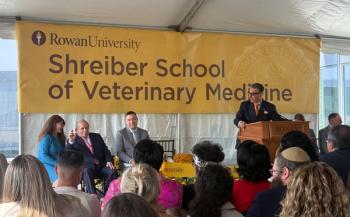
Treating glaucoma in your equine veterinary patients
There's no easy fix for this condition, but these tips can help veterinarians diagnose and manage the progression of disease.
When Dennis Brooks, DVM, PhD, DACVO, ophthalmology professor at the University of Florida College of Veterinary Medicine, attended veterinary school in the late 1970s, "horses didn't get glaucoma." At least that's what he was told.
GETTY IMAGES/CLIVE REES PHOTOGRAPHY
At that time there were no measuring devices to determine intraocular pressure (IOP), no tonometers. "Tonometry became available during the early 1980s so that we could measure the IOP on horses," says Brooks. "We found out that horses did get glaucoma and that it's treatable, so we can at least stabilize their remaining vision for a relatively long period of time."
Going back as far as the 1860s, literature suggests that army veterinarians used their fingertips to detect higher pressure in the diseased eyes of cavalry horses with uveitis.1 "At the time they called the condition hypertensive uveitis," says Brooks, "but they could not take measurements to determine it quantitatively. They knew that horses with 'moon blindness' had abnormal IOP, but they didn't understand the disease glaucoma in those early days of the practice."
Causes and physiology
Equine glaucoma is most often a result of intraocular inflammation from equine recurrent uveitis. Similar to glaucoma in humans, the disease in horses is sometimes painful and eventually results in vision loss. In the early stages of glaucoma, affected horses may only show subtle cloudiness of the cornea. An obstruction of aqueous humor outflow inside the front of the eye, or anterior chamber, causes the elevation in IOP.2 The increased IOP causes reduced blood flow to the retina and obstruction of optic nerve axoplasmic flow, eventually resulting in retinal cell death, compression of the optic nerve and blindness.2
Aqueous humor is produced by the ciliary body processes and provides metabolic support to the cornea and internal structures of the eye. It flows from the posterior ocular chamber through the pupil to the anterior ocular chamber and drains from the eye via the iridocorneal or uveoscleral outflow pathways.2 Horses are unique in that up to 50 percent of aqueous humor drainage is via the uveoscleral outflow pathway.
Glaucoma in horses is seen as primary (i.e. resulting from an abnormally developed aqueous humor outflow pathway) and secondary (i.e. blocked outflow pathways in response to equine recurrent uveitis, intraocular tumors, corneal perforation or lens luxation). For some foals, it can also be a congenital condition present at birth.
Appaloosas are more susceptible to uveitis and glaucoma. And while the condition is thought to be genetic, no one really knows why these horses are affected. The bottom line? All horses can get glaucoma.3
Clinical signs
Clinical signs of glaucoma vary. They may be subtle, or one may observe a red, cloudy, painful or squinty eye, says Erica Tolar, DVM, DACVO, with Blue Pearl Veterinary Hospital in Louisville, Ky. Many horses with acute and chronic glaucoma don't exhibit the classic signs of ocular pain, which include eye closure (blepharospasm) and excess production of tears (epiphora).2
"Eyes can only do so many things when they're 'angry,'" Tolar says. "A practitioner may see a horse with a 'cloudy' eye that stains negative. The next step is to check the IOP, which will give us one more piece of the puzzle."
Horses with glaucoma show variable pupillary light reflex deficits, but the disease often results in dilation of the pupil (mydriasis) due to damage to the retina, optic nerve and iris sphincter muscle. Horses with concurrent intraocular inflammation may have miosis (constriction) of the pupil. Dyscoria, or an abnormally shaped pupil, may result from adhesions between the iris and the lens capsule.2
Diagnosis
"Having the right tools to help decipher what's occurring in the horse's eye is most important," Tolar says. "In the case of glaucoma, having a rebound or applanation tonometer, or access to one from a small animal practitioner is essential."
Right eye of a horse with primary glaucoma. Note the diffuse corneal edema and multiple, linear Descemetâs striae across the cornea. (IMAGES COURTESY OF DR. ERICA TOLAR AND DR. DENNIS BROOKS)
A rebound tonometer is a handheld, battery-operated instrument with a magnetic probe that is projected at the cornea. The six readings are averaged within the machine and displayed in an easily viewed window opposite the probe.1 Applanation tonometers differ from rebound tonometers in that they measure the force required to flatten the corneal surface over a standard area. Also handheld and portable, applanation tonometers require topical anesthesia to obtain accurate readings.1
When diagnosing glaucoma, practitioners need to consider the different causes. If the glaucoma is not secondary to inflammation but primary, which is rarely reported and not well-documented in the equine literature, there's a malfunction in how the drainage angle is formed. "If it is secondary to uveitis or inflammation, the inflammatory cells block the drainage angle, and the pressure starts creeping up," Tolar says. "That's when you start to get damage. Damage occurs to the optic nerve and retina, and it upsets the flow of nutrition to the lens, resulting in cataract formation. The increase in IOP is indicative of glaucoma."
Right eye of a horse with vertical corneal edema.
"In my practice, I might lecture a group of veterinarians and ask, 'How many of you have seen a horse with uveitis?' and most hands will go up. Of those same practitioners, most will say they have not observed glaucoma," Brooks says. "I then tell them that they probably have seen horses with glaucoma; they just weren't aware of it."
An early clinical sign of glaucoma can be vertical corneal edema, Brooks continues. This finding appears to be correlated with a risk of developing glaucoma,3 but no one knows why, he says. Practitioners who see uveitis, vertical corneal edema or dilated pupil should check IOP, which can help confirm a glaucoma diagnosis.
Another early sign of glaucoma is a clinical change in the drainage angle, Brooks says. And horses with uveitis are certainly at an increased risk of developing glaucoma.
Practitioners need to be suspicious in order to catch glaucoma early; however, early signs are usually not painful in horses, so the condition can be difficult to diagnose. Squinting may be the only early detectable sign. "Using a pen light to routinely conduct eye exams will allow you to see the fluid within the eye and whether the angle is blocked, beginning the buildup of IOP," Brooks says. "This simple test will also help you learn what a bad angle looks like."
Treatment
Glaucoma is a treatable disease, even in its early stages. Brooks recommends putting at-risk horses on prophylactic treatment, such as timolol, which is used to treat open-angle and occasionally secondary glaucoma by reducing aqueous humor production through blockage of the beta receptors on the ciliary epithelium. "Administered twice daily, it really helps some of these horses by lowering the IOP," he says. "As glaucoma is a progressive disease, timolol and other drugs work for a limited period of time, delaying further eye deterioration up to three years."
Horses are quite responsive to therapy, so administration of timolol or similar treatments will decrease IOP, delaying optic nerve damage and inevitable blindness. Each horse responds differently to treatment, but without it, they will go blind faster.
In addition to beta-blockers such as timolol to reduce IOP, other treatment options include beta-adrenergic agonists, including betaxolol, levobunolol and metipranolol (though these three have not been evaluated in horses), Tolar says. Brinzolamide (1 percent) and dorzolamide (2 percent) can be used to inhibit carbonic anhydrase, an enzyme in the ciliary body epithelium required for aqueous humor production, thereby decreasing IOP.
Horses with glaucoma can also be treated with laser ciliary body ablation to decrease the production of fluid in the eye. This can be done with standing sedation or under general anesthesia. "Sometimes you can lower the IOP and keep them relatively healthy for two to three years," Brooks suggests. "Unfortunately, no glaucoma treatment offers a permanent fix. The treatments are management tools, as the disease is progressive by nature and ultimately leads to blindness. Therefore, treatment requires tweaking and adjusting, according to the patient's needs."
Comparing equine and companion animal cases
"One of the biggest differences we see in companion animals is that both dogs and cats in the acute phase of glaucoma seem to present with more pain," Tolar says. "In horses, you don't necessarily see the obvious signs of pain. But dogs very often present with acute onset of symptoms and will be very uncomfortable, just laying around and avoiding play. We just might not recognize those subtle signs in horses like we do in companion animals."
The squinty, red, cloudy eye seen with glaucoma is consistent across species. Cats can get both primary and secondary glaucoma, but primary is more rare, as it is in horses.
Referral to a veterinary ophthalmologist
If a practitioner sees an abnormal eye and he or she is not sure whether it's glaucoma, it's a good idea to pick up the phone, call a referring ophthalmologist to discuss the case and, if necessary, have the ophthalmologist examine and treat the patient, Tolar says.
"If practitioners are able to describe the condition, we might be able to point them in one direction or another, but it's tough to fully diagnose an ophthalmologic case over the phone, especially glaucoma," she says. "A photo sent by mobile device or email might help, but it depends on the quality of the image—and there are some things you can't see in a photo. But in the end, the image may suggest to us that a direct referral to a veterinary ophthalmologist is best."
Ed Kane, PhD, is a researcher and consultant in animal nutrition. He is an author and editor on nutrition, physiology and veterinary medicine with a background in horses, pets and livestock. Kane is based in Seattle.
Reference
1. Percivall W. Hippopathology: A systematic treatise on the disorders and lameness of the horse, with their modern and most approved methods of cure. London, England: Longmans, Green and Co., 1876;77-102.
2. Tolar EL, Labelle AL. How to diagnose and manage horses with glaucoma, in Proceedings. Am Assoc Equine Pract 2013;59:174.
3. Brooks DE. Equine ophthalmology made easy. Jackson, Wyo: Teton NewMedia Press, 2002.
Newsletter
From exam room tips to practice management insights, get trusted veterinary news delivered straight to your inbox—subscribe to dvm360.






